
Link building is the lifeblood of search engine optimization, and for SaaS companies, it’s non negotiable.
But let’s be real—building links in the SaaS space isn’t a walk in the park. The rules are different, the challenges are unique, and the opportunities? Well, they’re massive.
In this guide, we’re ditching the generic advice. We dive deep into the world of SaaS link building and show you how to create a successful link-building strategy that will actually work for your software company.
Ready to transform your link profile and skyrocket your organic visibility? Let’s get started!
What Is Link Building for SaaS?
Link building for SaaS is about getting other websites to link to your website or software platform.
Think of these links as votes of confidence—the more votes (or links) you have from reputable sources, the more trustworthy your website appears to search engines like Google.
Here’s a visual representation of how it works:
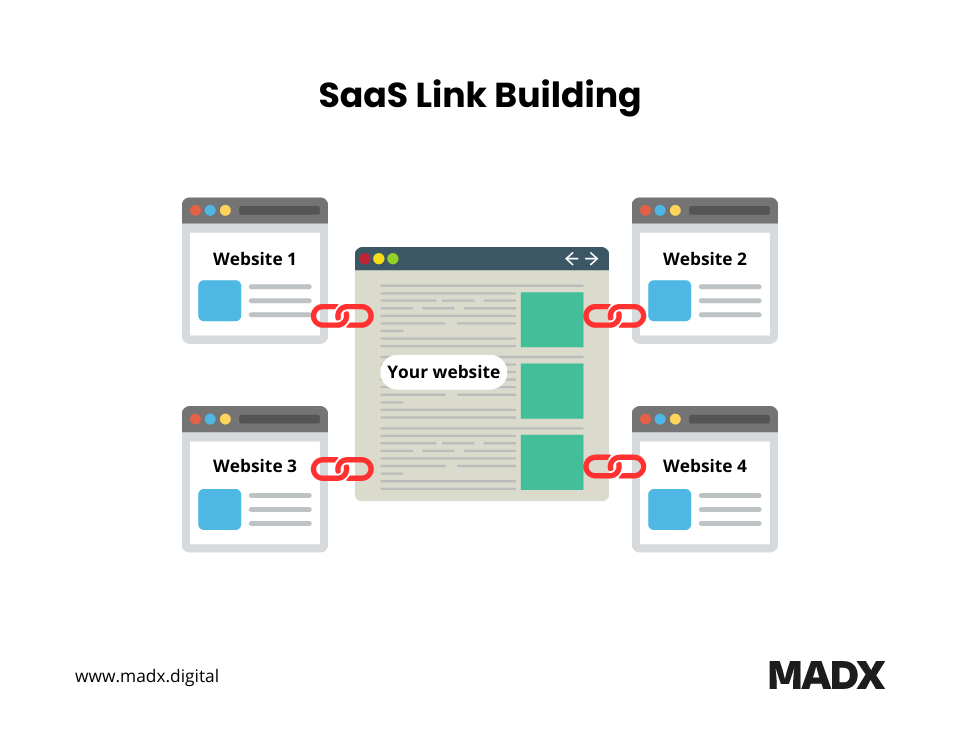
This trust translates into better rankings in search results, which means more people are likely to find your SaaS website when they’re looking for solutions like yours.
However, it’s not just about the number of links. The quality of the websites linking to you and how relevant their content is to yours also matter.
Essentially, effective SaaS link building involves strategically acquiring links from authoritative and relevant sources to boost your visibility and attract more potential customers.
We’ll show you how it works below.
Why Is Link Building for SaaS Important?
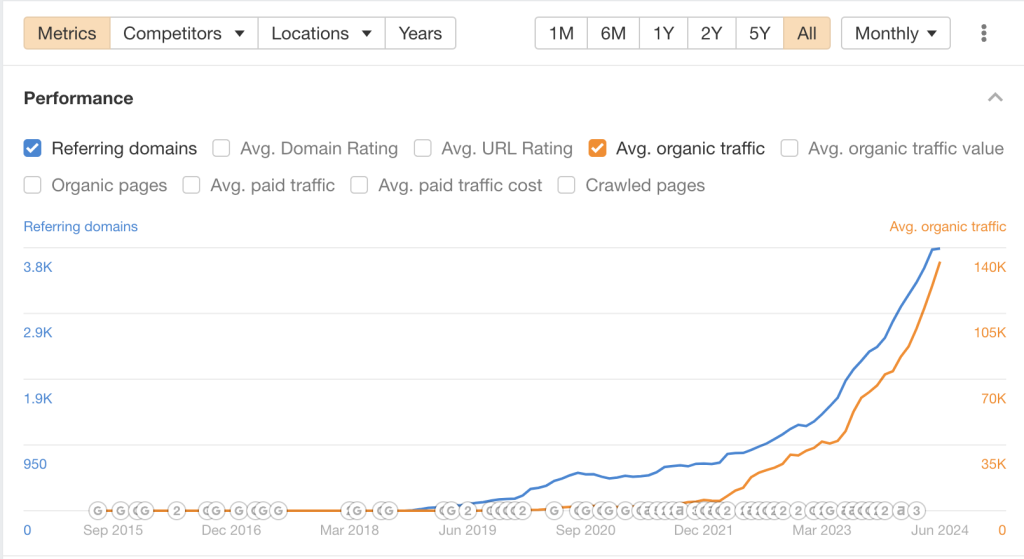
Source: Ahrefs
The impact of strategic link building is undeniable. Just look at Userpilot.com.
As their number of referring domains grew, so did their organic traffic, creating a snowball effect that catapulted their online visibility.
Let’s do the math:
Say their organic traffic reaches around 130,000 visitors per month, and let’s assume a conservative 2% conversion rate; that’s a whopping 2,600 potential new users.
We can take it a step further:
If each new user opts for Userpilot.com’s most affordable package at $249/month, the potential monthly recurring revenue (MRR) generated from these organic conversions alone could reach an estimated $657,360.
But the value of link building doesn’t stop there. By focusing on acquiring high-quality backlinks, Userpilot.com has not only increased traffic, but also enhanced its brand authority and credibility within the SaaS industry.
This, in turn, can lead to increased customer lifetime value (CLTV) as users are more likely to trust and remain loyal to a reputable brand.
While individual results may vary, Userpilot.com‘s success story underscores the undeniable power of link-building campaigns in driving organic growth and fueling revenue for SaaS companies.
SaaS Link Building Challenges
And, of course, along with the good comes the bad. SaaS companies face distinct hurdles in their pursuit of high-quality backlinks:
It’s very competitive
The SaaS landscape is incredibly competitive, with many established players boasting high domain authority (DA) and domain rating (DR).
| 💡Key point: What is domain authority?
Domain authority (DA) is a metric developed by Moz that predicts how well a website will likely rank on search engine result pages (SERPs). It ranges from 1 to 100, with higher scores indicating a greater likelihood of ranking higher. Domain rating is Ahrefs’ measure of DA. A higher DA is generally better, but what constitutes a “good” DA can vary depending on your industry and competitors. Usually, a DA of 40-50 is considered average, 50-60 is good, and 60+ is excellent. However, comparing your DA to your direct competitors is more helpful than focusing on an absolute number. |
These metrics, often used to gauge a website’s authority and backlink profile strength, are usually higher in the SaaS industry.
For example, consider the keyword “time-tracking software.” It has a keyword difficulty of 94, making it difficult for newer companies to compete for top keyword rankings. Also, the top 10 search results on Google will usually have a DR of around 70+.
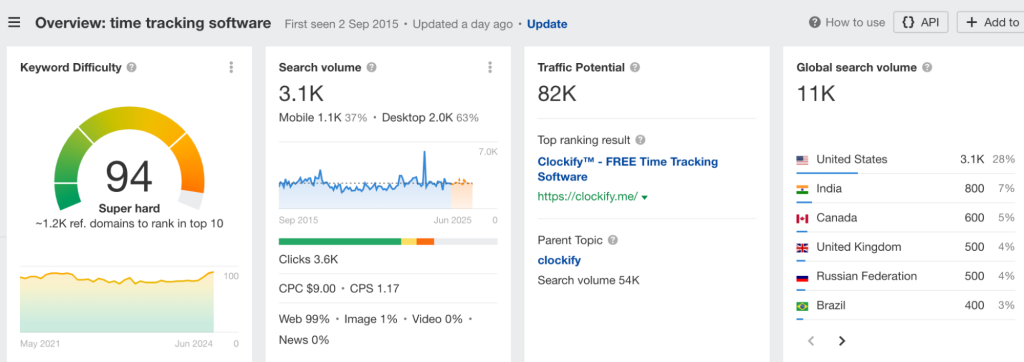
Source: Ahrefs
| 💡Key point: What is keyword difficulty?
In Ahrefs, keyword difficulty (KD) is a metric that estimates how challenging it would be to rank on the first page of Google’s search results for a specific keyword. Here’s how it works:
|
High professional standards
SaaS products often cater to professionals and businesses with discerning standards.
This means that any content created for link-building purposes must be meticulously researched, well-written, and visually appealing to resonate with this sophisticated audience.
Achieving this level of quality can be time-consuming and expensive.
Technical complexity
Many SaaS products are inherently technical, requiring a deep understanding of complex concepts and industry jargon.
Translating this complexity into content that is both informative and engaging for a broader audience can be a challenge. Striking the right balance between technical accuracy and accessibility is crucial in link building for SaaS.
Limited relevant opportunities for link-building efforts
Unlike broader industries, SaaS tools often serve very specific purposes. This specialization can limit the pool of relevant websites for potential link partnerships.
Finding authoritative websites relevant to your niche and target audience requires meticulous research and creative outreach strategies.
The Advantages of Building Links for SaaS Businesses
SaaS businesses are uniquely positioned to reap significant rewards from link building. Here’s why:
Topical authority
SaaS companies often possess deep expertise in the problems their software solves. This knowledge base naturally translates into valuable content that other relevant websites eagerly reference.
For example, Ahrefs, a popular SEO toolset, regularly publishes in-depth guides and case studies on various aspects of SEO, making it a go-to resource for backlinks from marketing and SEO blogs.
Genuine value proposition
Many SaaS products offer a freemium model, providing users access to valuable tools and features at no cost. This strategic approach not only generates positive word-of-mouth, but also fosters trust and familiarity with the brand.
Here is how freemium models drive backlinks:
➡️ Building trust: By offering a free version of their product, SaaS companies demonstrate confidence in their offerings and allow users to experience their value firsthand. This builds trust and credibility, making users more likely to recommend the product to others.
➡️ Creating familiarity: Users who engage with a free tool become familiar with its interface, features, and overall user experience. This familiarity lowers the barrier to entry for upgrading to a paid plan, as users are already comfortable with the product.
➡️ Word-of-mouth advertising: When users find a free tool genuinely useful, they’re more likely to share it with their colleagues, friends, or online communities. This organic word-of-mouth can lead to backlinks from blogs, social media posts, and other online platforms.
An example of this is Canva, a graphic design platform that offers a free version with robust features, making it a popular choice for bloggers, small businesses, and individuals looking to create professional-looking visuals.
This has led to countless backlinks (21.9 MILLION, to be exact!) from websites and tutorials recommending their platform.
Users who start with the free version often upgrade to a paid plan as their needs grow, demonstrating the effectiveness of the freemium model in building trust and familiarity, and ultimately driving revenue.
Source: Ahrefs
The Top SaaS Link-Building Strategies
Now that we have discussed the pros and cons of SaaS link building, we’ll walk you through some link-building strategies that work well in this niche.
Get blogging
A well-maintained blog is the cornerstone of any successful SaaS link-building strategy and has a range of benefits:
✅ Showcasing expertise: A blog post allows you to share in-depth knowledge about your industry, your product, and the problems your software solves. This positions your brand as a trusted authority, making it more likely for other websites to link to your content.
✅ Demonstrating activity: Regularly updating your blog with fresh, relevant content signals to search engines like Google that your website is active and up-to-date. This can positively impact your search rankings and overall visibility.
✅ Attracting backlinks: High-quality blog posts naturally attract relevant backlinks from other websites seeking to reference valuable information or provide additional resources to their audience.
Guest posting to amplify your reach
While creating content for your blog is crucial, guest posting on reputable websites can further expand your reach and backlink profile. By contributing a guest post to other platforms, you can:
➡️ Tap into new audiences: Guest posts allow your SaaS company to reach a broader audience who might not be familiar with your brand yet.
➡️ Build relationships: Establish connections with other industry leaders and website owners.
| 💡Ready to unlock the power of guest posting for your SaaS business? Dive into our comprehensive guide to discover the best opportunities and learn how to craft pitches that get accepted. |
Provide free tools
One of the most effective link-building strategies for SaaS companies is to offer free tools and resources that provide genuine value to their target audience.
These tools act as magnets for backlinks, attracting users and other websites that find them useful and want to share them with their audience.
Why widget link building works:
✅ It’s valuable: By offering a free tool, you’re providing something of value up-front, creating goodwill and establishing your brand as a helpful resource.
✅ Shareability: Useful tools are naturally more likely to be shared and embedded on social media, blogs, and forums, leading to increased visibility and backlinks.
✅ Demonstrates your expertise: Free tools showcase the capabilities of your SaaS product, enticing users to explore your paid offerings.
Types of free tools
The type of free tool you create will depend on your specific niche and target audience. Here are a few popular options:
Calculators
Interactive calculators that help users solve specific problems or estimate costs are highly shareable and can attract backlinks from relevant websites.
ℹ️ Example:
For instance, Omnicalculator’s Mortgage Calculator helps users estimate their monthly mortgage payments, compare different loan options, and understand the financial implications of buying a home.
Its user-friendly interface and detailed results have made it a popular resource for personal finance blogs and websites, generating backlinks in the process.
Checklists or templates
Providing free checklists or templates can save users time and effort, making them valuable resources often linked to by blogs and tutorials.
ℹ️ Example:
Hootsuite’s Social Media Calendar Template helps social media managers plan and schedule their content in advance.
Its ease of use and versatility have made it a popular resource for social media blogs and tutorials, generating backlinks and driving traffic to Hootsuite’s website.
Generators or analyzers
Tools that generate content ideas, analyze website performance, or provide other valuable insights can attract backlinks from marketers, bloggers, and other professionals.
ℹ️ Example:
AnswerThePublic’s Keyword Tool generates a visual map of questions and phrases people search for. It’s a great resource when you are doing keyword research.
It also helps creators discover new content ideas and understand their audience’s search intent, attracting backlinks from marketing and SEO blogs.
Use stats pages and trend reports to build referral traffic
SaaS platforms often collect and analyze vast amounts of user data. This provides a unique opportunity to create valuable content that attracts backlinks and establishes industry authority.
By leveraging your data, you can create insightful reports and statistics pages that reveal trends, patterns, and benchmarks within your industry.
These resources can be incredibly valuable to other businesses, journalists, researchers, and bloggers seeking reliable data to support their work.
If you lack sufficient data, consider commissioning original research on a relevant topic within your niche. Partnering with a reputable research firm can lend credibility to your findings and increase the likelihood of your research being cited and linked to other sources.
A great example is this social media marketing statistics report by Sprout Social:
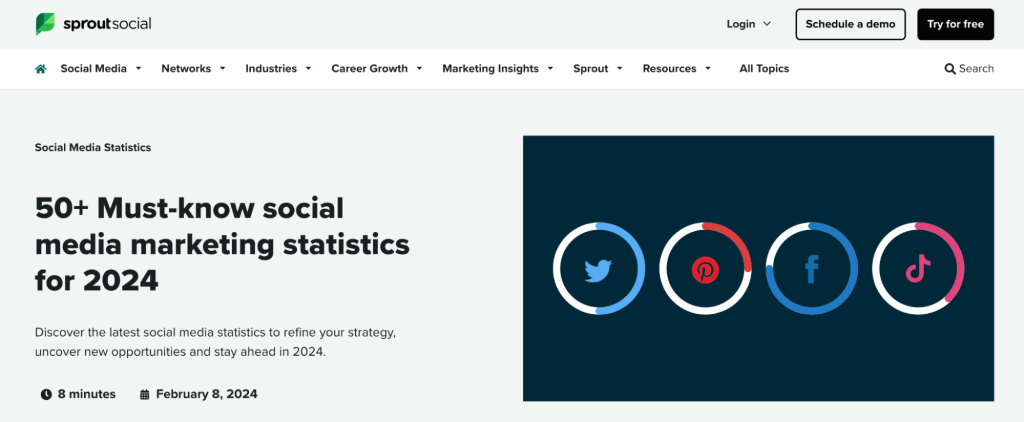
Source: Sprout Social
According to Ahrefs, this report has over 12,000 backlinks and gets 2,200 visitors every month. Also, the report has high-quality backlinks from over 3,000 domains, some of which have domain ratings of over 90.

Source: Ahrefs
Compiling comprehensive research reports is difficult and time-consuming. However, this type of link-building campaign may be well worth the effort, as you could get rewarded with many backlinks from authoritative sites.
Create infographics
Linkable content is the backbone of most link-building outreach campaigns. One of the ways to do this is by creating sharable infographics.
Here’s why infographics are a powerful link-building strategy for SaaS companies:
✅ Visual appeal: Infographics break down complex information into easily digestible visuals, making them more engaging and shareable.
✅ Data storytelling: They allow you to craft a compelling narrative with your data, highlighting key trends, insights, and takeaways
✅ Linkable assets: Eye-catching and informative infographics are frequently cited and linked to by websites, blogs, and social media users.
What’s great is that you can repurpose your existing stats pages, reports, or research findings into infographics to maximize their reach.
Visualize key findings, trends, or comparisons to create engaging visuals that resonate with your target audience. Here is a great example from the Sprout Social report we discussed above:
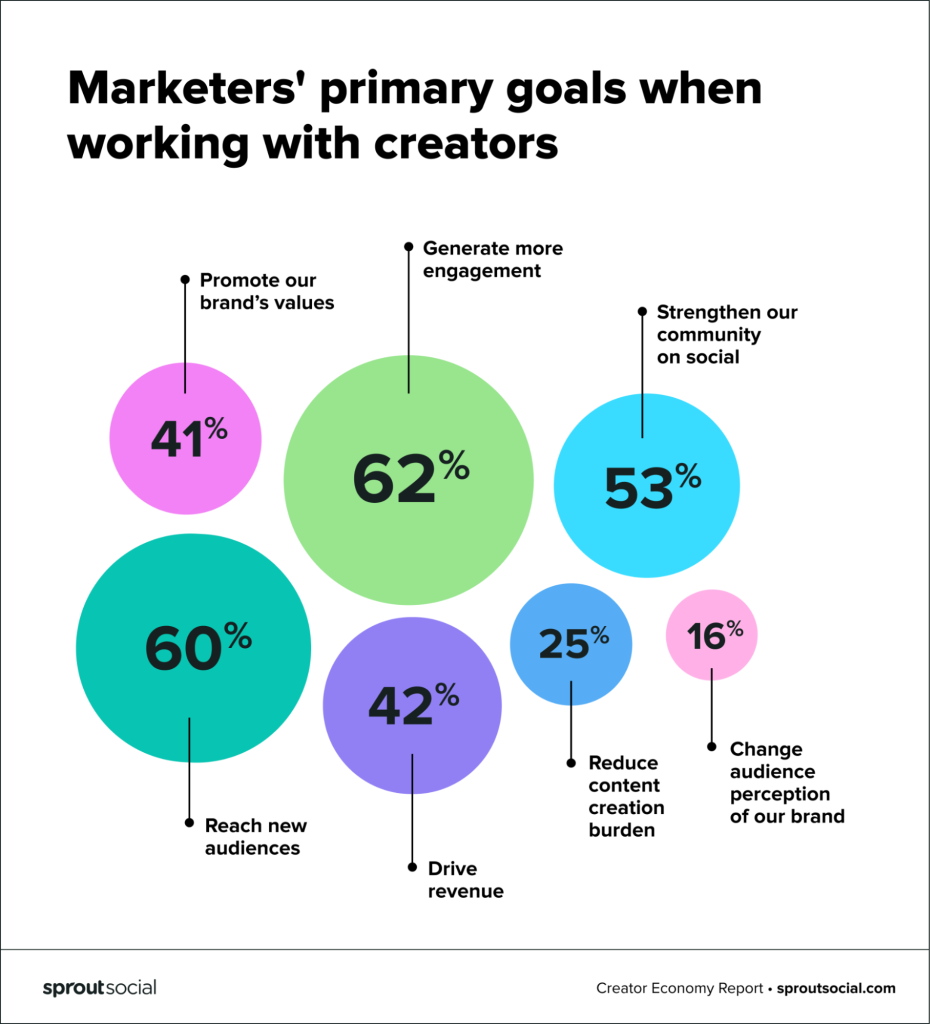
Source: Sprout Social
In addition to creating their own infographics, they have used other infographics from major players like Hubspot. It is a win-win situation:
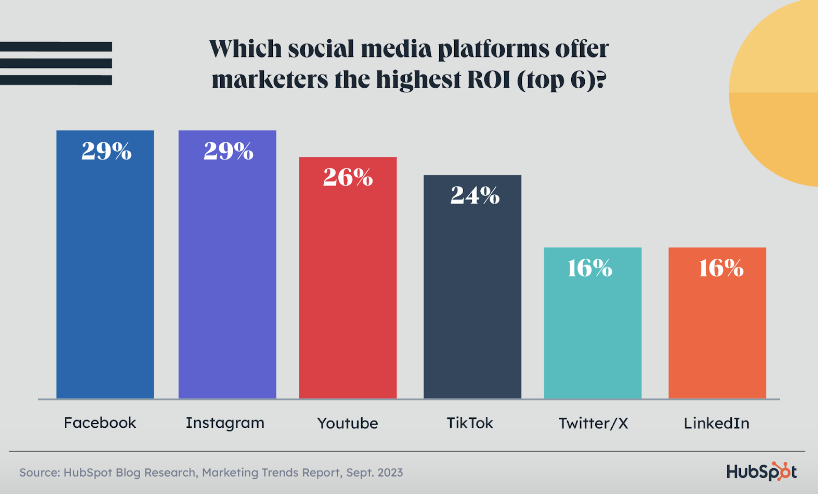
Source: HubSpot
| 💡Key point: Actively promote infographics on your website, social media channels, and relevant online communities. This will expand your reach and may encourage more people to use your infographic on their website. |
Find uncredited images
Your SaaS company likely produces a variety of visual assets, from product screenshots and diagrams to original graphics and infographics.
These visuals often find their way onto other websites, blogs, and social media platforms. While this can be great for brand exposure, it’s even better when those images link back to your website.
Several tools and techniques can help you discover instances where your images are being used without proper attribution:
Google reverse image search
- Go to images.google.com and click on the camera icon in the search bar:
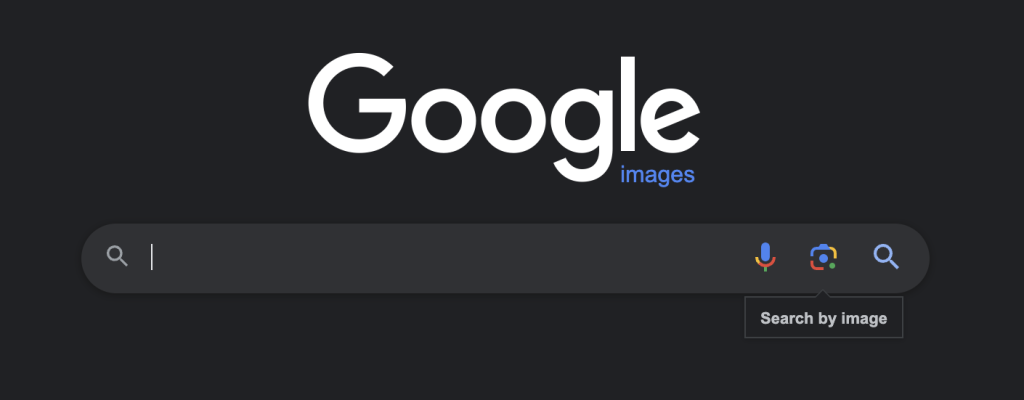
Source: Google Images
2. You have two options. You can paste the URL or upload an image from your computer:

Google will show you a wealth of information about the image, typically including:
- Visually similar images: Other images that look like the one you uploaded, even if they’re not exact matches.
- Websites using the image: A list of websites where the image appears, which can help you discover uncredited usage.
- Different sizes: Variations of the same image in different sizes or resolutions.
- Image details: Technical information like the file type (e.g., JPG, PNG) and image size.
- Related images: Other images that are contextually related to the one you uploaded.
Here’s an example:

Source: Neil Patel
Using other search engines
➡️ Bing Visual Search: Similar to Google, Bing allows you to perform a reverse image search by uploading an image or pasting its URL.
➡️ TinEye: This specialized reverse image search engine is excellent for finding exact matches of your image across the web.
➡️ Yandex Images: This Russian search engine offers a robust reverse image search function, particularly useful for finding international image sources.
How to turn unliked images into high-quality links
Once you’ve identified uncredited usage of your images, reach out to the website owner or author.
Politely request that they add a link to your website as proper attribution. Explain the benefits of doing so, such as giving credit where it’s due and helping their readers find the original source of the information.
Most site owners will be happy to comply with your request, especially if you approach them in a friendly and professional manner.
Get your product included in “best of” roundups
Tech and business websites frequently publish curated lists highlighting the “best” tools or resources in specific categories.
These roundups, sometimes called listicles, are among the best link-building techniques for SaaS companies.
Getting included in a roundup typically comes with a backlink to your website, boosting your SEO and driving referral traffic.
Aside from building links, being included in these resource pages has other benefits:
➡️ Targeted exposure: Roundups in relevant sites attract readers actively seeking solutions in your niche, making them a highly targeted audience for your SaaS product.
➡️ Credibility boost: Being featured in a “best of” list instantly adds social proof to your brand and could help generate leads.
Here’s an example of a roundup of the best time-tracking software for 2024 to illustrate our point:
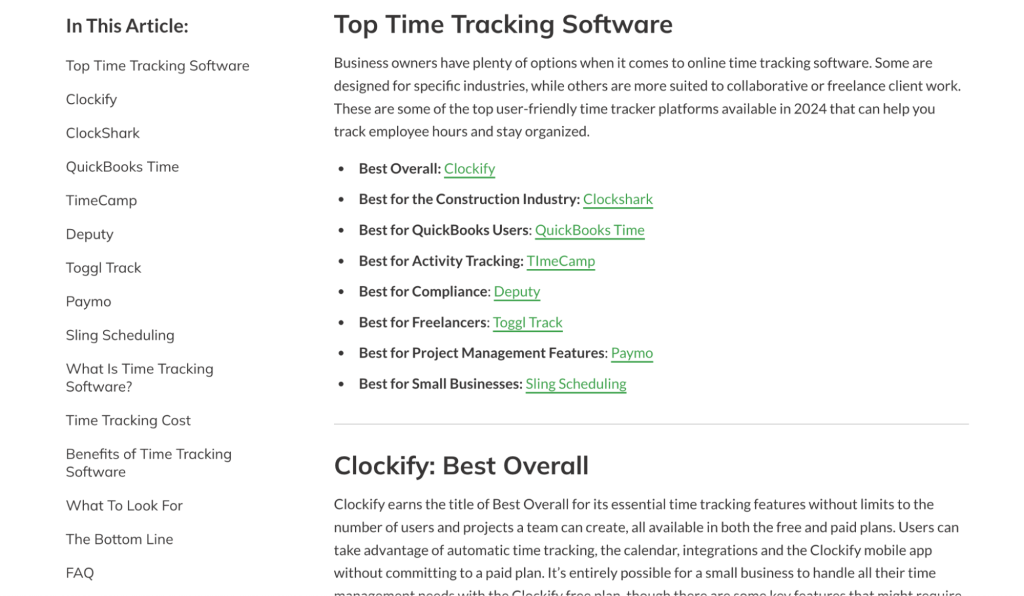
Source: MarketWatch
Podcasting to build links
Podcasts have emerged as a powerful tool for SaaS companies—especially startups—to not only share their expertise, but also secure more links.
Many business-focused podcasts are eager to feature founders, tapping into the compelling narratives of innovation and growth that resonate with their audience.
For example, the popular podcast “How I Built This” has featured numerous SaaS founders, like Rob Kalin of Etsy and Melanie Perkins of Canva, leading to significant exposure and backlinks for their companies.
When you’re a guest on a podcast, it often results in a link to your website in the show notes or episode description. This not only drives direct traffic, but also signals to search engines that your content is credible and authoritative.
By strategically selecting podcasts that align with your target audience, you can tap into their established listener base and position yourself as a thought leader in your industry. The combined effect of direct traffic, SEO benefits, and brand awareness makes podcast appearances a winning strategy for SaaS link building.
Leverage broken link building
Broken link building is a strategic approach to acquiring backlinks by identifying broken links on other websites (links that lead to a “404 Page Not Found” error) and then offering your relevant content as a replacement. This is a win-win scenario:
✔️ For the website owner: They get to fix broken links on their site, improving user experience.
✔️ For you: You gain a valuable backlink from a relevant source.
Here’s how to use Ahrefs for broken link building:
Start by identifying websites in your niche or industry that have high authority. For the purposes of this example, we’re going to use the SaaS review site G2.
Next, enter the G2 domain in Ahrefs’ “Site Explorer”:

Source: Ahrefs
Navigate to “Outgoing links” and then to “Broken links.” This will show you a list of broken outbound links on that site.
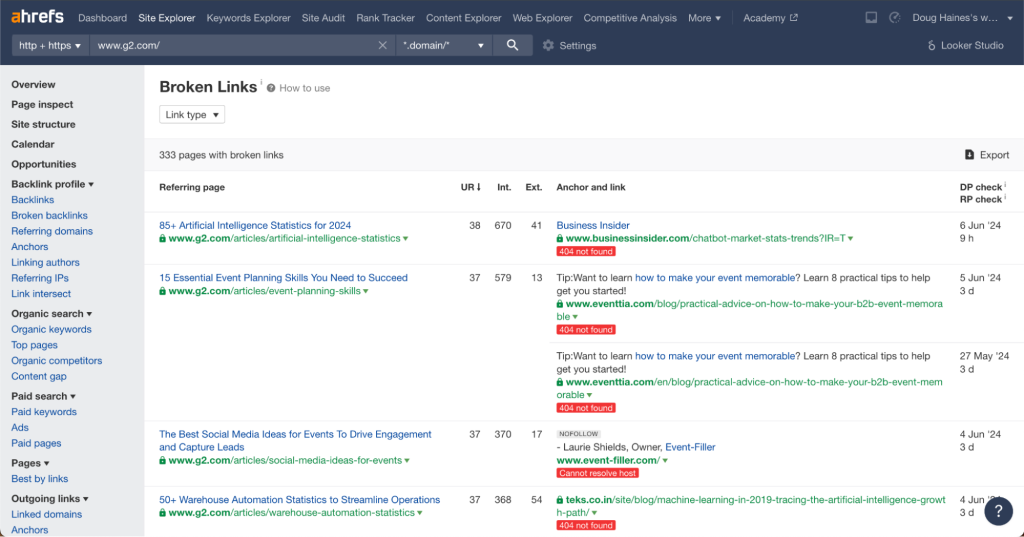
Source: Ahrefs
Review the list of broken links to identify ones that are relevant to your content. Look for broken links pointing to content similar to what you can offer.
If you already have content that can serve as a replacement for the broken link, ensure it’s high-quality and relevant. If not, create new content that matches or surpasses the quality of the original content.
| 💡Key point: You can also use Ahrefs Content Explorer. This tool allows you to search for broken pages based on specific keywords or topics. Filter for broken pages and sort by referring domains to find pages with existing backlinks. |
Get quoted by using Connectively (formerly HARO)
SaaS companies possess a wealth of industry knowledge, making them valuable resources for journalists seeking expert insights.
Getting quoted in relevant articles can earn you powerful backlinks from reputable publications, boosting your website’s authority and visibility.
One effective way to connect with journalists is through platforms like Connectively (formerly known as Help A Reporter Out or HARO).
This platform streamlines finding and responding to media inquiries, opening doors to valuable media coverage, and is a solid link-building strategy for your SaaS business.
Here’s how to get started:
First, sign up for a free account and fill out your profile with your areas of expertise, interests, and contact information:
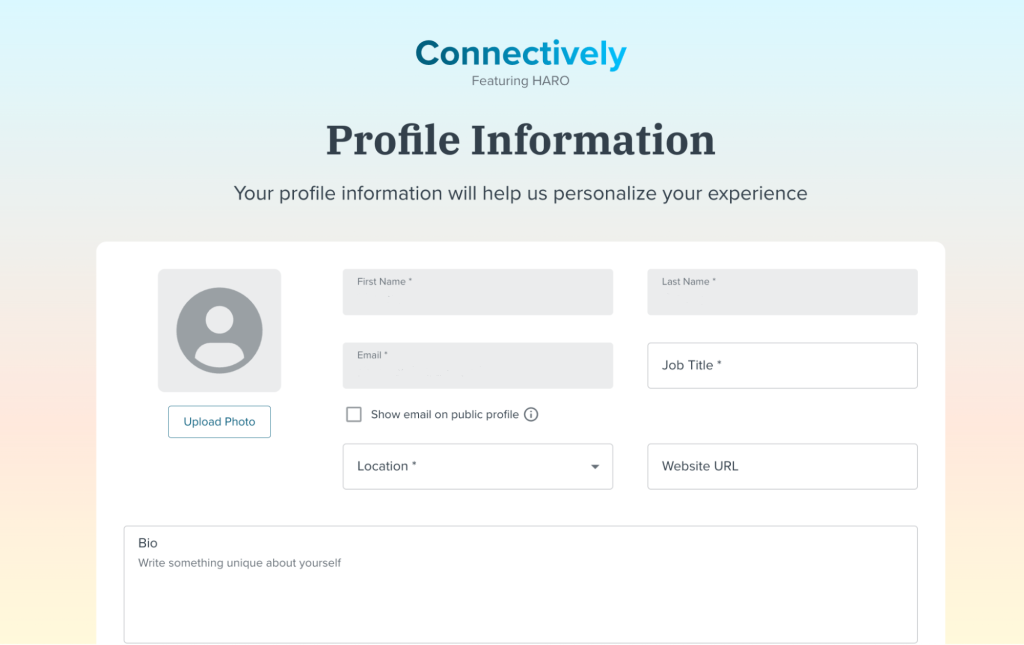
Source: Connectively
Once your account is set up, you can browse through a feed of media opportunities (queries) posted by journalists seeking experts to interview for their stories.
On the dashboard, you can filter queries by keywords, topics, publications, and deadlines to find requests relevant to you.

Source: Connectively
Say your company specializes in marketing workflow automation. The request below would be a great opportunity for an expert from your organization to get exposure for your SaaS tool—and build backlinks in the process!
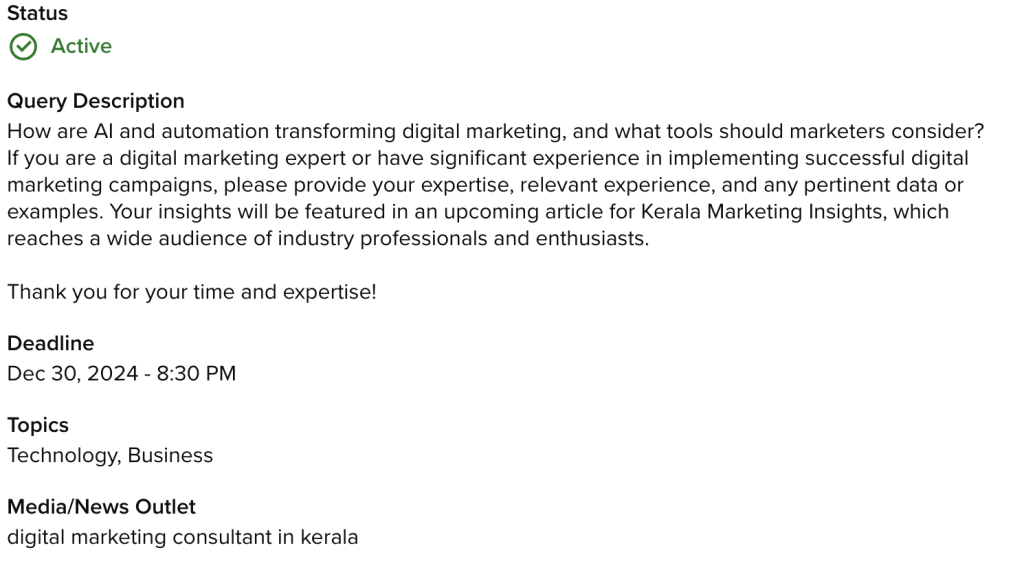
Source: Connectively
The next step is to click on the “pitch” button on the right-hand side of the query and craft a personalized pitch highlighting your relevant experience, credentials, and unique insights.
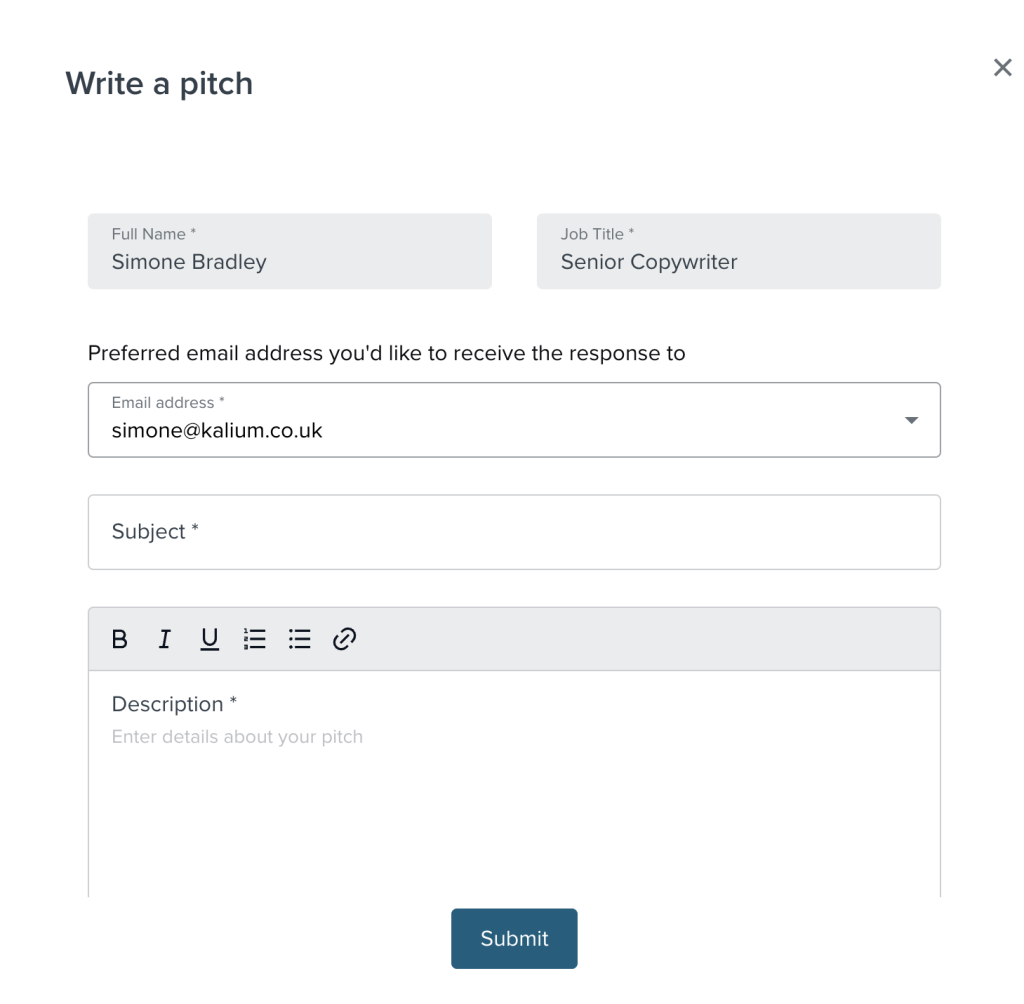
Source: Connectively
Types of Backlinks to Avoid
Lastly, building a sustainable SEO strategy is a long-term endeavor. While it can be tempting to chase quick wins, engaging in black-hat link-building tactics can have devastating consequences for your SaaS brand’s reputation and search rankings.
Link building strategies to avoid at all costs:
❌ Over-promotion: Spamming your links on social media or forums can trigger spam filters and damage your brand’s reputation.
❌ Misleading links: Ensure that any anchor text used to link to your website accurately reflects the content on your page. Misleading links can be seen as manipulative and harm your credibility.
❌ Link exchange: While not always harmful, excessive link exchange can raise red flags with search engines and dilute the value of your backlinks.
❌ Links from shady websites: Associating your brand with low-quality or spammy websites like link farms, PBNs, and casino sites can damage your reputation and backlink profile. Regularly audit your backlinks and disavow any toxic or irrelevant links.
Final Thoughts: SaaS Link Building
Building a strong backlink profile is essential for any SaaS company looking to thrive in the competitive digital landscape.
It’s not just about SEO; it’s about establishing your brand as a trusted authority, driving targeted traffic, and ultimately growing your business.
Remember, the key is to focus on quality over quantity, create valuable content, leverage your unique strengths, and build genuine relationships with other websites.
By following these principles and implementing the techniques outlined in this guide, you can unlock the full potential of link building for your SaaS and achieve long-term success.
Authority Builders is a link-building agency that helps SaaS brands acquire high-quality, natural links to boost your rankings and generate more traffic to your site. If you’re ready to take your link building to the next level, get in touch today!
